Spotlight on... creators of the Japan pavilion at the London Design Biennale 2023
2023/6/21
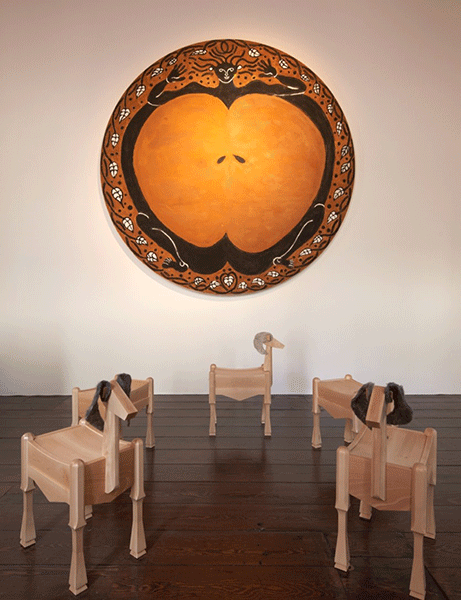 Installation image
Installation imagePhoto credit: Edmund Sumner
The Japan pavilion "The Future is Rural" at the London Design Biennale 2023 delved into enduring challenges faced by contemporary Japan, including depopulation and an ageing society. The pavilion highlights the contributions of artists, designers, and activists residing in rural Japan. Their projects draw inspiration from cross-cultural exchanges with local communities, as well as the rich traditions and histories in Japan and the UK.
We interviewed the creators of the Japanese Pavilion, Yuki Sumner (Curator), Katsunobu Yoshida and Ayuko Inaba, Ryo Okamoto, Tatsuhiro Ara in our latest "Spotlight on" series.
Can you tell us about your pavilion – what is the main idea behind it and why did you choose to focus on it?
[Yuki Sumner] I started thinking about rural Japan when I attended the lecture on Zoom by Atelier Bow Wow for the Royal Academy of Arts in 2021. They talked about how their focus shifted to rural areas in more recent years and I heard about Mr Yoshiharu Tsukamoto’s engagement with the Small Earth Community in rural Chiba set up by Mr Yoshiki Hayashi. The Community allows city people to toil the rice fields on weekends. The city folks change in the process as a result, learning from the local people, traditional skills (not just farming techniques); they then go back to the city and change the city as well. Rural life can then be protected and preserved. I wanted to show this two-way system by highlighting the artists and designers who are changing rural Japan.
Do you think you were able to showcase a side of Japan that most people are not yet familiar with?
[Ayuko Inaba] Yes. The exhibition touches on the daily lives of people in rural Japan, and in that sense, it created an opportunity for people to learn more about new aspects of Japan.
What is your connection to rural Japan, and how does it affect your work as artists?
[Ayuko Inaba] For me, living in a rural area it is about a sense of community. And our work as artists is influenced by the work in the village, by helping each other and doing things together.
[Katsunobu Yoshida] This idea of community work relates to the theme of the London Design Biennale of ‘collaboration’. Without cooperation and without helping each other, rural life does not really operate properly.
We interviewed the creators of the Japanese Pavilion, Yuki Sumner (Curator), Katsunobu Yoshida and Ayuko Inaba, Ryo Okamoto, Tatsuhiro Ara in our latest "Spotlight on" series.
Can you tell us about your pavilion – what is the main idea behind it and why did you choose to focus on it?
[Yuki Sumner] I started thinking about rural Japan when I attended the lecture on Zoom by Atelier Bow Wow for the Royal Academy of Arts in 2021. They talked about how their focus shifted to rural areas in more recent years and I heard about Mr Yoshiharu Tsukamoto’s engagement with the Small Earth Community in rural Chiba set up by Mr Yoshiki Hayashi. The Community allows city people to toil the rice fields on weekends. The city folks change in the process as a result, learning from the local people, traditional skills (not just farming techniques); they then go back to the city and change the city as well. Rural life can then be protected and preserved. I wanted to show this two-way system by highlighting the artists and designers who are changing rural Japan.
Do you think you were able to showcase a side of Japan that most people are not yet familiar with?
[Ayuko Inaba] Yes. The exhibition touches on the daily lives of people in rural Japan, and in that sense, it created an opportunity for people to learn more about new aspects of Japan.
What is your connection to rural Japan, and how does it affect your work as artists?
[Ayuko Inaba] For me, living in a rural area it is about a sense of community. And our work as artists is influenced by the work in the village, by helping each other and doing things together.
[Katsunobu Yoshida] This idea of community work relates to the theme of the London Design Biennale of ‘collaboration’. Without cooperation and without helping each other, rural life does not really operate properly.
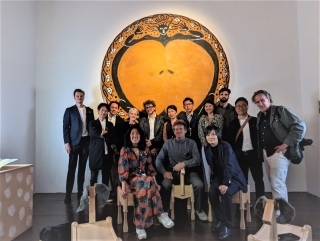 Photo credit: Akira Kindo at Eric Parry Architects
Photo credit: Akira Kindo at Eric Parry Architects
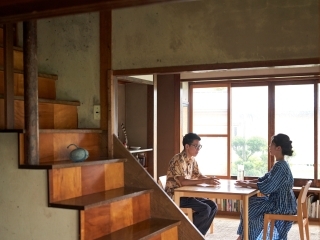 Katsunobu Yoshida & Ayuko Inaba at their home in Yamagata | Photo credit: Edmund Sumner
Katsunobu Yoshida & Ayuko Inaba at their home in Yamagata | Photo credit: Edmund Sumner
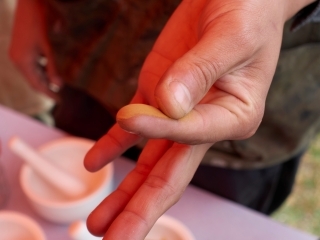 Ochre is a by-product waste material of coal mining
Ochre is a by-product waste material of coal mining Photo credit: Yuki Sumner
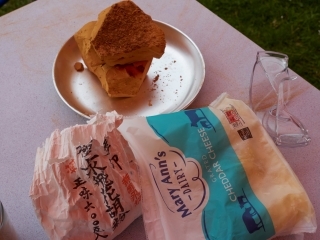 Cheese was also used to make ink
Cheese was also used to make ink Photo credit: Yuki Sumner
Can you tell us about your motivation to use coal and the collaboration with the National Coal Mining Museum in Wakefield?
[Yoshida Katsunobu] Coal is an important material, it was a part of the industrial revolution. However, coal has the sustainability issue. When I thought about British culture, about what a single individual can or cannot do dealing with such an issue, I thought it would be a good material to focus on. At the workshop, in Wakefield, I discovered that coal has many positive uses. Then, we decided to use ochre, a by-product waste material of coal mining, as a source of ink in our pavilion as well.
[Yoshida Katsunobu] Coal is an important material, it was a part of the industrial revolution. However, coal has the sustainability issue. When I thought about British culture, about what a single individual can or cannot do dealing with such an issue, I thought it would be a good material to focus on. At the workshop, in Wakefield, I discovered that coal has many positive uses. Then, we decided to use ochre, a by-product waste material of coal mining, as a source of ink in our pavilion as well.
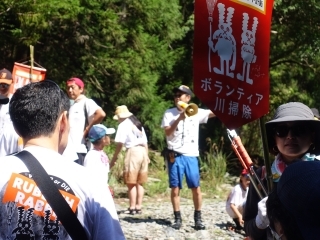 Ryo Okamoto instructing a group gathered to collect rubbish in rural Nara | Photo credit: Edmund Sumner
Ryo Okamoto instructing a group gathered to collect rubbish in rural Nara | Photo credit: Edmund Sumner
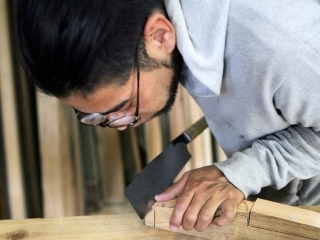 Portrait of Tatsuhiro Ara at work
Portrait of Tatsuhiro Ara at workPhoto Credit: Katsunobu Yoshida
Can you tell us about your work derived from the Rubbish Rabbit Project, and the social message behind it?
[Ryo Okamoto] I believe that it is our job to create art that adds value to things that are undervalued. I wanted to bring people's attention to sustainability issues, by making something that is accessible for them. Because it is very difficult to convey the value of undervalued things in words, I have created Rubbish Rabbit mascots, as well as a rap song, to get more attention and help from people.
What were the most enjoyable and most challenging aspects of preparing the pavilion?
[Tatsuhiro Ara] The challenging bit and the fun bit are the same. It was the first time for me to collaborate with people from the UK. The challenge was to design the chairs here in Japan and then translate the design into drawings to be made in England. Mr Yoshida and I have been collaborating for many years and we always work through a trial-and-error process and by testing things out using our own bodies. The collaborators in the UK (Mauro Dell’Orco, Steve Cook and Riccardo Pellizzon from Workshop East) work very differently and it was difficult to explain this process to them.
[Ryo Okamoto] I believe that it is our job to create art that adds value to things that are undervalued. I wanted to bring people's attention to sustainability issues, by making something that is accessible for them. Because it is very difficult to convey the value of undervalued things in words, I have created Rubbish Rabbit mascots, as well as a rap song, to get more attention and help from people.
What were the most enjoyable and most challenging aspects of preparing the pavilion?
[Tatsuhiro Ara] The challenging bit and the fun bit are the same. It was the first time for me to collaborate with people from the UK. The challenge was to design the chairs here in Japan and then translate the design into drawings to be made in England. Mr Yoshida and I have been collaborating for many years and we always work through a trial-and-error process and by testing things out using our own bodies. The collaborators in the UK (Mauro Dell’Orco, Steve Cook and Riccardo Pellizzon from Workshop East) work very differently and it was difficult to explain this process to them.
The exhibition was generously supported by Maeda Corporation, Eric Parry Architects, Niwaki and Sasakawa Foundation.
To find more about the Japanese Pavilion participants, sponsors and collaborators, please visit: londondesignbiennale.com/pavilions/2023/japan
To find out more about London Design Biennale, please visit: londondesignbiennale.com
To find more about the Japanese Pavilion participants, sponsors and collaborators, please visit: londondesignbiennale.com/pavilions/2023/japan
To find out more about London Design Biennale, please visit: londondesignbiennale.com
